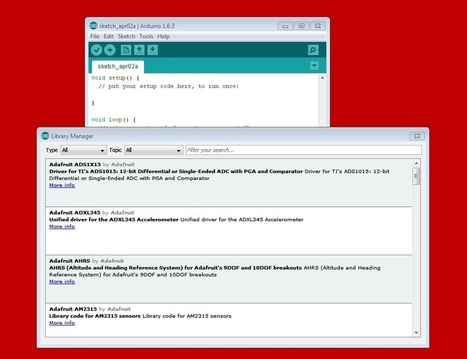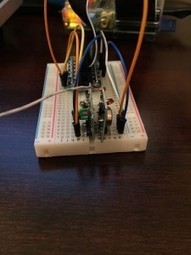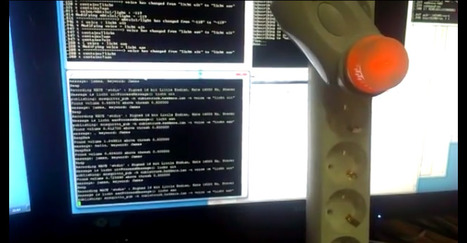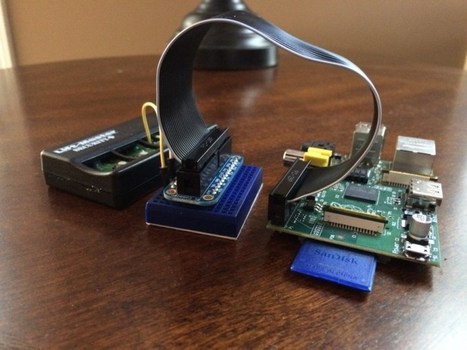 Your new post is loading...

|
Scooped by
Vincent Demay
April 8, 2015 4:47 PM
|
During the last 2 weeks I’ve collected a lot of ESP-8266 power usage charts as shown here. Enough to conclude that a ESP8266 can be used to build battery powered sensors

|
Scooped by
Vincent Demay
April 3, 2015 2:20 AM
|
Big things are happening! Sceptical? Download the latest Arduino IDE, and go to Sketch - Include Library - Manage Libraries
The new IDE is much more responsive as well!

|
Scooped by
Vincent Demay
March 24, 2015 8:48 AM
|
Let’s start exploring a bit more about Intel Edison. As you may already know, Intel provides 2 different hardware platforms to work with Edison development board: the core module is called Intel Edison Compute Module, while the 2 extension boards are called Intel Edison Arduino Board and Intel Edison Breakout Board respectively. We refer to them as the Arduino module and mini-breakout board, respectively. The tutorial of this week is called Getting Started with Intel Edison Mini Breakout Board:

|
Scooped by
Vincent Demay
March 18, 2015 4:01 AM
|
In our kitchen, the light that falls on the counter is blocked by the kitchen cabinets. It would be nice to have some light when preparing food, but often when you need light, your hands are dirty. I came up with the idea of running a strip of LEDs under the cabinets and being able to control them by waving your hand under the cabinet to turn them on. You can adjust the brightness by moving your hand down from just under the cabinet to counter level to control brightness based on the distance from the cabinet.
I am using an ultrasonic range sensor to determine the hand distance between the cabinet and the counter. I don't want to run the sensor all the time because, even though we can't hear the 40kHz chirp, I imagine the dogs and bird (our pets) can hear it. Additionally, I imagine there is a limited lifetime on the sensor. So I added a pyroelectric infrared (PIR) sensor that will only activate the ranging when it senses movement around the counter.

|
Scooped by
Vincent Demay
March 3, 2015 11:30 AM
|
Have you ever wanted to wirelessly control power outlets from your phone? You could buy a Belkin WeMo Switch for over $40 for 1 outlet or build your own with 5 outlets for under $35 if you already own a Raspberry Pi. Hopefully this post will guide you in the right direction.

|
Scooped by
Vincent Demay
February 18, 2015 11:05 AM
|
Do you want to find the right sensor for your DIY project based on the Arduino microcontroller? Well, finding the right sensor requires research and to facilitate this process, you’ll find all the info you need in this article.

|
Scooped by
Vincent Demay
February 2, 2015 7:39 AM
|
I love to use WiFi in my home automation projects. On this website, you can find a lot of projects using Arduino along with the CC3000 WiFi chip from TI.

|
Scooped by
Vincent Demay
January 22, 2015 11:30 AM
|
HAL-9000 (Space Odyssey), Mother (Alien), The Matrix, Jarvis (Iron Man), KITT – who doesn’t know them? And since a few days there’s Jasper, voice control for the Raspberry Pi.
An RPi, microphone, speaker and network connection is all you need (and the Jasper software package of course).

|
Scooped by
Vincent Demay
January 18, 2015 6:25 AM
|
I’ve often talked about how to use a atmega in in standalone mode without any Arduino board:
with a 16mhz resonator
or without any resonator using internal clock
In both cases, you need to load the bootloader to the Atmega chip.

|
Scooped by
Vincent Demay
January 16, 2015 7:58 AM
|
The CoPiino is a Arduino compatible Atmel 1284 based "shield" for the Raspberry Pi that allows remote editing and uploading of Arduino sketches using a web browser. Access the CoPiino app running on the Raspberry Pi with a web browser to edit and upload new sketches. Transfer sensor data from the CoPiino to the Raspberry Pi for display by the Apache Web Server, and stored by the MySQL server running on the Pi.

|
Scooped by
Vincent Demay
December 8, 2014 3:14 AM
|
In this blog, I’ve often talked about how to use a atmega in in standalone mode without any Arduino board:with a 16mhz resonatoror without any resonator using internal clockIn both cases, you need to load the bootloader to the Atmega chip.

|
Scooped by
Vincent Demay
November 28, 2014 5:28 AM
|
Since a while, I’m trying as I can to reduce the power consumption of my Arduino based system. Remember, I wrote a post about optimizing Arduino consumption few months ago. In this post I will explain how to use the Arduino internal quartz reducing significativelly the power consumption and making system last longer with 2 LR6 batteries.
Using the internal clock instead of a 16mhz resonator helps my system to last longer on batteries : from 17 days to 3 or 4 months

|
Scooped by
Vincent Demay
November 7, 2014 12:24 PM
|
These last days I spent some time playing with ethernet on my Arduino. The main goal is to make the Arduino accessible directly for the web via the Web. To do so I played with several shields or modules.
|

|
Scooped by
Vincent Demay
April 4, 2015 9:53 AM
|
A little while back I released the very first version of ESPToy — a ESP8266 Development Board with a few useful on-board components like color LED, button, and temperature sensor.

|
Scooped by
Vincent Demay
April 1, 2015 2:18 AM
|
Raspberry Pi Solar Weather Station
"I wanted to build a Raspberry Pi weather station that was able to sustain itself off grid and send me the results through a wireless connection, from anywhere! This project really has had its challenges, but luckily powering the Raspberry Pi is one of the main challenges that has been made easy by using the PiJuice as a power supply with it's added solar support."

|
Scooped by
Vincent Demay
March 20, 2015 5:38 PM
|
The ESP8266 is an amazing WiFi chip that can be used in several home automation applications. In this article, we are going to use it to control a lamp remotely via WiFi.

|
Scooped by
Vincent Demay
March 7, 2015 4:24 PM
|
The ESP866 is a tiny WiFi chip that has the huge advantage to come at a ridiculous price point: $5.It is perfect to be uses in home automation: low price and easy to use with AT commands.

|
Scooped by
Vincent Demay
March 3, 2015 5:27 AM
|
Very often we need to connect some type of mechanical switch to an Arduino as an input device. Also very often, there is mechanical slop in a switch, so the arduino sees one activation of the switch as multiple activations. This is called switch bounce. You can write code that looks at the state of the switch, saves it to a variable and waits for a short period of time and looks again to see if the button is still pressed, or you can debounce in hardware and save code space and complexity.

|
Scooped by
Vincent Demay
February 17, 2015 10:04 AM
|
His hack is relatively simple. He started with the garage door opener remote. He removed the momentary switch that was normally used to active the door. He bridged the electrical connection to create a circuit that was always closed. This meant that as long as the remote had power, the switch would be activated. Now all [Tanner] had to do was remove the battery and hook up the power connectors to his Raspberry Pi. Since the remote works on 3.3V and draws little current, he is able to power the remote directly from the Pi. The Pi just has to turn its pin high momentarily to activate the remote.

|
Scooped by
Vincent Demay
January 23, 2015 5:21 PM
|
In this post I will explain how you can expend the number of IO of your Arduino via Maxim 1wire DS24O8.The DS2408 is an 8-channel, programmable I/O 1-Wire® chip. PIO outputs are configured as open-drain and provide an on resistance of 100Ω max.

|
Scooped by
Vincent Demay
January 20, 2015 8:56 AM
|
“LiPo (Lithium Polymere) batteries are interesting batteries for IoT as they are nt so much expensive, easy to get with multiple form factors and multiple capacities.”

|
Scooped by
Vincent Demay
January 16, 2015 11:30 AM
|
Coming from the Arduino world, most everything I do is 5v logic. It's been a switch for me now that I'm integrating my Raspberry Pi's into my Arduino solutions (they really are complementary).

|
Scooped by
Vincent Demay
January 14, 2015 10:14 AM
|
We always admired the amazing hardware and software that DIY home automators can put together and Mat Smiths project to build his ultimate home control panel is a great example.

|
Scooped by
Vincent Demay
December 4, 2014 10:02 AM
|
Today I am introducing the first version of RFToy — an Arduino-compatible gadget for interfacing with Radio Frequency (RF) modules.

|
Scooped by
Vincent Demay
November 8, 2014 12:21 PM
|
|
 Your new post is loading...
Your new post is loading...


































